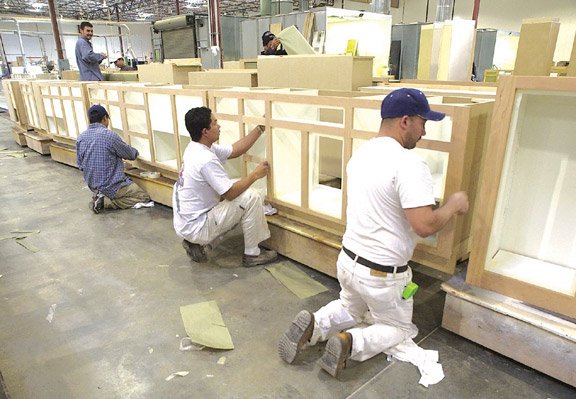By KOLLIN KOSMICKI, JONATHON JEISEL and CAROL HOLZGRAFFE
Staff Writers
More than 20 years ago local industrial developer Ken Lindsay
would often fly from his headquarters in San Jose to Santa Barbara
for business. On each flight, he could remember seeing vehicles
stuck in traffic on U.S. 101 traveling north into Silicon
Valley.
By KOLLIN KOSMICKI, JONATHON JEISEL and CAROL HOLZGRAFFE
Staff Writers
More than 20 years ago local industrial developer Ken Lindsay would often fly from his headquarters in San Jose to Santa Barbara for business. On each flight, he could remember seeing vehicles stuck in traffic on U.S. 101 traveling north into Silicon Valley.
Lindsay would fly over the empty landscapes of Morgan Hill, Gilroy and then Hollister. And each time, as he looked down at the one-way stream of commuters, he thought: “Why don’t businesses build in the outlying communities?”
He was particularly attracted to Hollister because of its unique airport, which he viewed as mostly undiscovered, a potential anchor that would eventually draw million-dollar industries.
“I just had this vision that companies would want to come here,” he said. “There’s no commute, an airport and it didn’t have the high costs of the Bay Area.”
Lindsay, owner of Sierra Pacific Associates, Inc., said the two biggest expenses for an employer are costs of labor and facilities.
If he could develop where the land was less expensive, it would draw solid employees to an area with affordable homes, and they wouldn’t be forced to commute two, three and four hours each day.
But the key for Lindsay was the Hollister Municipal Airport because of its accessibility for employers. If someone developed the land, it would allow potential employers to fly in clients right at their doorsteps. And it would allow Lindsay to fly in potential land buyers to tour the site and fly back to wherever they came from – all in one day’s time.
Through a former architecture student Lindsay had taught years earlier at Cabrillo College, he met a man who owned land by the airport and was interested in Lindsay developing at the location.
Lindsay agreed, a decision that resulted in the Hollister Business Park. And in the long run, it has resulted in a steady sprouting of industrial development in the area.
“I’ve been hammering away at this for a long time,” he said.
He later spearheaded and teamed up with other developers on numerous other business parks in Hollister – all surrounding the airport – including the Northpoint Business Park, Citation Business Park and most recently the AirPark Business Center.
Lindsay was a south of Silicon Valley success story. But his fortunes have turned upside down as of late – not only because of a staggering economy, but also because the City of Hollister was hit with a moratorium on building permits until October 2005 for mismanagement of its sewer system .
On May 4, 2002 – when 15 million gallons of treated sewage spilled into the San Benito riverbed – the state pushed the pause button on any new development within city limits. Lindsay has since lost several multi-million dollar deals because most companies are no longer interested in building, and the Airpark Business Center sits virtually empty. Lindsay said industrial development in Hollister is essentially “out of business.”
“I can’t tell you how painful this is,” he said. “It’s very difficult for us right now.”
Unless the sewer moratorium is lifted sometime soon, which doesn’t seem likely, Hollister will probably remain limited in its industrial development and economic expansion, according to officials such as Al Martinez, the city’s economic development director.
“Right now, the total economic environment is bad,” he said.
The Gilroy and Morgan Hill business communities are no strangers to sewer moratoriums, as Lindsay pointed out. Those cities also experienced the financial doldrums of a sewer problem-enduced halt on issuance of building permits in the 1980s that temporarily crippled the cities’ level of growth.
And even now, Hollister is not alone in the region, being in a state of temporary economic disharmony. Both Gilroy and Morgan Hill have also experienced rapid growth in the last decade, only to be jammed, just like that morning commute on Highway 101, in the last two years.
But as a whole, the region can still boast of several economic strongholds and a potential for future growth if the tides begin to turn anytime soon. Each community is somewhat unique in makeup, each specializing in different economic arenas.
Gilroy’s retail market continues on a trail of growth, despite insecurity in Silicon Valley.
In 1996, Gilroy had roughly $600 million in taxable retail sales, according to Bill Lindsteadt, executive director of the Gilroy Economic Development Corporation. By 2001, that amount had grown to $1.1 billion – and it doesn’t look to be stopping there.
The city is already a Mecca in one sense in regional retail because of the Gilroy Premium outlets, which is a major attraction for regional shoppers and beyond. Customers come by the busload from 40 or more miles away and spend hours at the 575,000-plus square feet of shopping at U.S. 101 and Leavesley Road, which opened in 1990 and have undergone several expansions. The center’s 145 stores generate as much as $2 million in sales tax revenue for Gilroy per year.
Since 1997, the industry’s Outlet Retail Merchant Association has recognized the center as one of the top performing outlet centers in the United States, according to outlet officials.
The Regency Development Corporation’s 450,000-square-foot center at the junction of U.S. 101 and Highway 152 is expected to draw customers from a 20-mile radius to a mix of national-scale retailers stocked with everything from bedding to books to bath salts.
Expected tenants include names such as Target, Kohl’s Department Store, Bed, Bath and Beyond, Ross Dress For Less, Best Buy and Barnes and Noble Booksellers.
Meanwhile, Newman Development Corp. is building a center on the other side of Highway 152 – a complex that is expected to feature several major retail tenants.
A second phase of the center will likely seek national chain tenants and restaurants similar to those at Regency. Names bandied about in the early going have included Home Goods, Linens and Things and Marshall’s. A multiplex theater has also been raised as a possibility.
Population growth, land affordability and the city’s location at the axis of two highways are reasons developers favor Gilroy for such centers, according to city economic development officials.
Proponents said the new development will eventually draw upward of $4 million in crucial sales tax revenue per year for the city by mid-decade – dollars that would otherwise be likely to flow to other communities – while at the same time providing much-desired amenities for Gilroy residents.
Being the nearest city to Silicon Valley, Morgan Hill has experienced the worst of the sluggish economy of the three communities. City officials in recent years have made it clear they are not interested in retail glitz. And its once thriving industrial park landscape – many of the buildings almost brand new – are now empty.
However, Morgan Hill has braced itself for its own distinct challenge: How can it move forward and increase business opportunities while still keeping its image as a small, family-oriented community?
Both the Chamber of Commerce and the City’s Business Assistance and Housing Services department continue trying to entice new industry to the area.
The Chamber, intending to move its marketing efforts into overdrive, asked the City Council in 2002 for additional funding to hire a professional marketing director, to expand its offices to include a visitors center and to boost its marketing of the city to the world.
The city does have funds earmarked by the Redevelopment Agency for economic development and officials plan to use the money to subsidize moving costs if companies consider locating to Morgan Hill.
Once the storm of financial woes clears, the outlook for local businesses should follow suit. Hollister’s Economic Development Director Al Martinez put it best, referring to the draw of development, both commercially and industrially, south of Silicon Valley.
“Being off (U.S.) 101 is like buying beach property,” he said. “Everyone wants to be on the beach, and 101 is the beach.”















